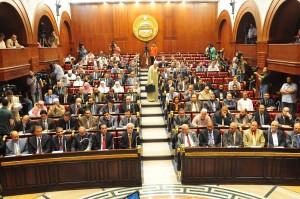Aga Khan revitalizes the residential community surrounding Al-Azhar Park
The 74-acre site in Darassa was filled with rubble and rubbish before the Aga Khan Trust for Culture (AKTC) transformed it into the beautiful Al- Azhar Park, with Islamic style gardens and wonderful views of the Citadel and Old Cairo. Now a favorite spot for many Cairo residents, it is one of the few peaceful, green spaces in this very congested city. The transformation of a rubble heap to a park was part of the Historic Cities Support Program (HCSP), which helps rejuvenate Muslim cities around the world, from Bosnia to Zanzibar to Syria. The idea is to revive Islamic architecture and improve the lives of the area’s residents at the same time. Al-Azhar Park project sparked even more work in the nearby Darb Al-Ahmar neighborhood. The park was over ten years in the making, and more than 80,000 truckloads of rubble and soil had to be cleared away before the site could be landscaped. During this process, a 12th century Ayyubid city wall, which had been buried up to its battlements, was discovered at the edge of the park site. “While at the beginning the idea was to provide the metropolis with a much needed green space at the heart of its historic agglomeration, the progressive uncovering of 1.3 kilometers of historic wall led to another major task-giving a new ‘face’ to the historic city as seen from the Park, wrote the Aga Khan about this discovery. Darb Al-Ahmar is the working class neighborhood that borders the wall, and became the focus of the HCSP’s most ambitious project to date, which aims to rehabilitate not just the architecture, but the social, cultural and economic status of the residents, an approach which Stefano Bianca, director of the HCSP, described as “truly integrated urban rehabilitation. The Trust found additional funding from the Ford Foundation and the Swiss-Egyptian Development Fund to carry out this ambitious scheme. Over the hundreds of years since the wall was built many houses and monuments in Darb Al-Ahmar have been built along it. Rather than taking the approach of simply tearing everything down, which would have destroyed the fabric of this neighborhood, the Trust conducted a site-by-site assessment of these buildings, deciding how to handle each one. Local houses are being rehabilitated, at a rate of 50 houses per year until 2007, and residents are offered credit to redo their own houses. Historical buildings are also being renovated, including the Umm Sultan Shaban Mosque from the 14 century and Khayrbeck, a complex including a 13th century mosque, palace and Ottoman house. The area’s economic and social revival is being encouraged through micro-loans offered to residents to start small businesses and also by offering training and apprenticeships in different crafts, from shoemaking, carpentry and masonry to computer and office work. The aim is to give people a stake in their own community, rather than displacing them in an attempt to save a historically significant area. This is important development work to the Aga Khan, who became the current Imam of the Shia Ismaili Muslims in 1957 at the age of 20. A direct descendent of the Prophet Mohammed (PBUH) and a Harvard graduate in Islamic History, he founded the Aga Khan Development Network to help economic, social and cultural development, particularly in Asia and Africa. Cairo was founded by the Aga Khan’s ancestors, the Fatimids, and he describes the city as “the richest treasure house of Islamic monuments anywhere in the world. The efforts of the Trust are to keep it that way, while helping modern residents develop and grow in their historic city. HCSP director Bianca has described the Trust’s projects in Cairo as “the boldest attempt to date to achieve interrelated conservation and development objectives.




